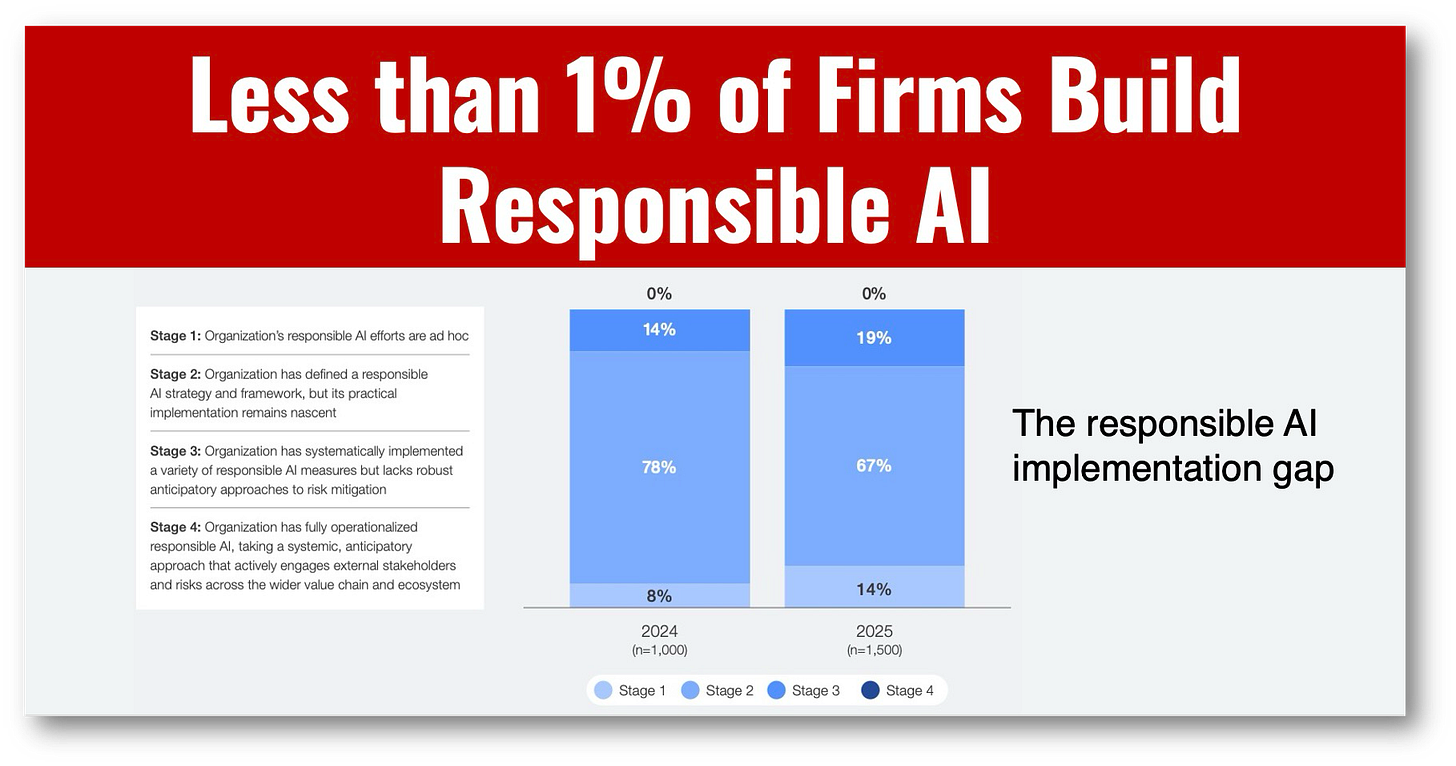This is my daily post. I write daily but send my newsletter to your email only on Sundays. Go HERE to see my past newsletters.
Responsible AI is good for business, and the WEF does a great job of providing nine practical suggestions that will help companies advance RESPONSIBLE AI innovation.
It is a tragic strategic error that responsible AI is seen by many as a process that delays AI innovation or embodies some form of tech weakness.
It is so prevalent that less than 1% of organizations have fully operationalized responsible AI in a comprehensive and anticipatory manner.
Lest you come away thinking that the above statistic is manipulated, check out this recent statistic from McKinsey:
“72% of organizations using AI report that their CEO is not responsible for overseeing AI governance and that 83% of boards do NOT oversee AI governance.”
Even those unschooled in responsible AI know that CEOs taking responsibility is the most basic step in promoting the culture of responsibility within any organization.
The irony is that responsible AI is good for business.
Responsible AI makes already skeptical clients more comfortable using it by assuring them that the company takes their needs seriously.
It also provides defense when the inevitable AI lawsuits hit.
Why is it so hard for companies to grasp this?
The notion that responsible AI slows innovation is fundamentally flawed and rushing AI to production is dangerous.
Companies ignoring or delaying responsible AI do so at their own risk.
👉Nine Plays for Building Responsible AI
➢ Play 1: Lead with a long-term, responsible AI strategy and vision for value creation
To secure both immediate AI opportunities and address evolving risk environments, companies must integrate a responsible AI strategy into their business strategy and AI innovation roadmap. For governments, organizational responsible AI maturity is more than ensuring trust and confidence; it can serve as a foundation for an adaptive AI policy life cycle necessary for new, dynamic AI capabilities like multimodal, robotic, agentic and beyond.
➢ Play 2: Unlock AI innovation with trustworthy data governance
Successful AI innovation depends on secure, high-quality and compliant data access with controls on processing, consent, cross-border transfers and AI deployment. Therefore, a modern data foundation must embed security into data workflows and AI systems as well as upgrade traditional security models.
➢ Play 3: Design resilient responsible AI processes for business continuity
Resilience is needed to future-proof organizations’ AI strategies and their governance, ensuring their adaptability to AI convergence with other technologies,29 emerging AI architectures, models and capabilities, and regulatory shifts. Organizations must also embed resilience, ensuring novel risks and opportunities are tackled as they arise.
➢ Play 4: Appoint and incentivize AI governance leaders
Responsible AI senior leaders enable robust governance frameworks that provide boards of directors with assurance of regulatory compliance across the enterprise, consistent risk thresholds and strategic business alignment.
➢ Play 5: Adopt a systematic, systemic and context-specific approach to risk management
The business implications of unmanaged AI risk exposure are far-reaching. A systematic, systemic and context-specific approach is needed to align responsible AI decision-making with risk-exposure and tolerances specific to the organization’s business size, sector, jurisdiction, operational structure and other contextual attributes.
➢ Play 6: Provide transparency into responsible AI practices and incident response
For industry and government leaders alike, transparency is foundational to trust, legitimacy and regulatory preparedness. Expectations rely on evidence of oversight, mitigation and continuous improvement. As governments begin mandating AI transparency requirements, companies that proactively develop reporting mechanisms will be better positioned.
➢ Play 7: Drive AI innovations with responsible design as the default
For responsible AI implementation to succeed at scale, organizations must reconfigure the foundational conditions that shape how AI is designed into products and services. Without integrating responsible design principles, even well-intentioned human-AI interaction design methodologies can erode user trust and social well-being.
➢ Play 8: Scale responsible AI with technology enablement
As AI applications multiply at pace and the risk landscape grows more complex, responsible AI technologies become indispensable – from operationalized platforms to systemic enablement and continuous oversight.
➢ Play 9: Increase responsible AI literacy and workforce transition opportunities
As organizations reinvent themselves around AI, fostering responsible AI literacy and cross-disciplinary skills across the enterprise is critical to prepare for cultural change, capability-building and talent transformation. For governments, investing in AI education is foundational to a public capable of informed decision-making in AI use and to a pipeline that meets increasing business demand for responsible AI experts.
HAND CURATED FOR YOU
🚀 Every week I scan thousands of articles to find only the best and most valuable for you. Subscribe to get my expertly curated news straight to your inbox each week. Free is good but paid is better.



